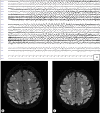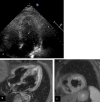Multiple Cerebral Infarcts and Encephalopathy as the First Clinical Manifestations of Hypereosinophilic Syndrome: A Case Report and Narrative Review
- PMID: 39473614
- PMCID: PMC11521416
- DOI: 10.1159/000539379
Multiple Cerebral Infarcts and Encephalopathy as the First Clinical Manifestations of Hypereosinophilic Syndrome: A Case Report and Narrative Review
Abstract
Background: Hypereosinophilic syndrome is characterized by a peripheral blood eosinophil count >1.5 × 103/μL on two different examinations within a month of each other and/or a 20% or higher percentage of eosinophils in a bone marrow section, associated with organ damage. Rarely, neurological manifestations may occur, even in the early stages. We report a case of idiopathic hypereosinophilic syndrome with Loeffler endocarditis presenting with multiple bilateral strokes and encephalopathy as the first clinical manifestations.
Summary: Hypereosinophilia and echocardiographic findings suggested a Loeffler's endocarditis. Blood hyperviscosity and small vessels inflammation induced by the hypereosinophilia itself, the embolization of intracardiac thrombus, along with the impaired clearance of microthrombi in the watershed areas, are the main mechanisms involved in the pathophysiology of stroke in the hypereosinophilic syndrome. Additionally, encephalopathy could be considered as a consequence of multiple cerebral infarcts and neurotoxicity induced by hypereosinophilia since our patient's confusion and aggressive behavior gradually remitted after steroid therapy was started.
Key messages: To the best of our knowledge, our case report is a rare instance highlighting neurological involvement as the earliest manifestation of hypereosinophilia. We aimed to elucidate the central nervous system involvement in this intriguing disorder, with the goal of encouraging clinicians to consider hypereosinophilic syndrome in the diagnostic assessment of rare stroke etiologies.
Keywords: Encephalopathy; Hypereosinophilic syndrome; Loeffler’s endocarditis; Stroke.
© 2024 The Author(s). Published by S. Karger AG, Basel.
Conflict of interest statement
The authors have no conflicts of interest to declare.
Figures


References
Publication types
LinkOut - more resources
Full Text Sources

